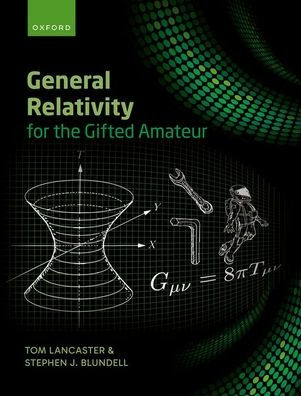General Relativity for the Gifted Amateur
General relativity is one of the most profound statements in science. It is a theory of gravity that allows us to model the large-scale structure of the Universe, to understand and explain the motions and workings of stars, to reveal how gravity interacts with light waves and even how it hosts its own gravitational waves.
It is central to our notions of where the Universe comes from and what its eventual fate might be. For those wishing to learn physics, general relativity enjoys a dubious distinction. It is frequently viewed as a difficult theory, whose mastery is a rite of passage into the world of advanced physics and is described in an array of unforgiving, weighty textbooks aimed firmly at aspiring professionals.
Written by experimental physicists and aimed at providing the interested amateur with a bridge from undergraduate physics to general relativity, this book is designed to be different. The imagined reader is a gifted amateur possessing a curious and adaptable mind looking to be told an entertaining and intellectually stimulating story, but who will not feel patronised if a few mathematical niceties are spelled out in detail.
Using numerous worked examples, diagrams and careful physically motivated explanations, this book will smooth the path towards understanding the radically different and revolutionary view of the physical world that general relativity provides and which all physicists should have the opportunity to experience.
1146555110
It is central to our notions of where the Universe comes from and what its eventual fate might be. For those wishing to learn physics, general relativity enjoys a dubious distinction. It is frequently viewed as a difficult theory, whose mastery is a rite of passage into the world of advanced physics and is described in an array of unforgiving, weighty textbooks aimed firmly at aspiring professionals.
Written by experimental physicists and aimed at providing the interested amateur with a bridge from undergraduate physics to general relativity, this book is designed to be different. The imagined reader is a gifted amateur possessing a curious and adaptable mind looking to be told an entertaining and intellectually stimulating story, but who will not feel patronised if a few mathematical niceties are spelled out in detail.
Using numerous worked examples, diagrams and careful physically motivated explanations, this book will smooth the path towards understanding the radically different and revolutionary view of the physical world that general relativity provides and which all physicists should have the opportunity to experience.
General Relativity for the Gifted Amateur
General relativity is one of the most profound statements in science. It is a theory of gravity that allows us to model the large-scale structure of the Universe, to understand and explain the motions and workings of stars, to reveal how gravity interacts with light waves and even how it hosts its own gravitational waves.
It is central to our notions of where the Universe comes from and what its eventual fate might be. For those wishing to learn physics, general relativity enjoys a dubious distinction. It is frequently viewed as a difficult theory, whose mastery is a rite of passage into the world of advanced physics and is described in an array of unforgiving, weighty textbooks aimed firmly at aspiring professionals.
Written by experimental physicists and aimed at providing the interested amateur with a bridge from undergraduate physics to general relativity, this book is designed to be different. The imagined reader is a gifted amateur possessing a curious and adaptable mind looking to be told an entertaining and intellectually stimulating story, but who will not feel patronised if a few mathematical niceties are spelled out in detail.
Using numerous worked examples, diagrams and careful physically motivated explanations, this book will smooth the path towards understanding the radically different and revolutionary view of the physical world that general relativity provides and which all physicists should have the opportunity to experience.
It is central to our notions of where the Universe comes from and what its eventual fate might be. For those wishing to learn physics, general relativity enjoys a dubious distinction. It is frequently viewed as a difficult theory, whose mastery is a rite of passage into the world of advanced physics and is described in an array of unforgiving, weighty textbooks aimed firmly at aspiring professionals.
Written by experimental physicists and aimed at providing the interested amateur with a bridge from undergraduate physics to general relativity, this book is designed to be different. The imagined reader is a gifted amateur possessing a curious and adaptable mind looking to be told an entertaining and intellectually stimulating story, but who will not feel patronised if a few mathematical niceties are spelled out in detail.
Using numerous worked examples, diagrams and careful physically motivated explanations, this book will smooth the path towards understanding the radically different and revolutionary view of the physical world that general relativity provides and which all physicists should have the opportunity to experience.
185.0
In Stock
5
1

General Relativity for the Gifted Amateur
640
General Relativity for the Gifted Amateur
640
185.0
In Stock

Product Details
| ISBN-13: | 9780192867407 |
|---|---|
| Publisher: | Oxford University Press |
| Publication date: | 04/29/2025 |
| Pages: | 640 |
| Product dimensions: | 7.64(w) x 9.96(h) x 1.46(d) |
About the Author
From the B&N Reads Blog
